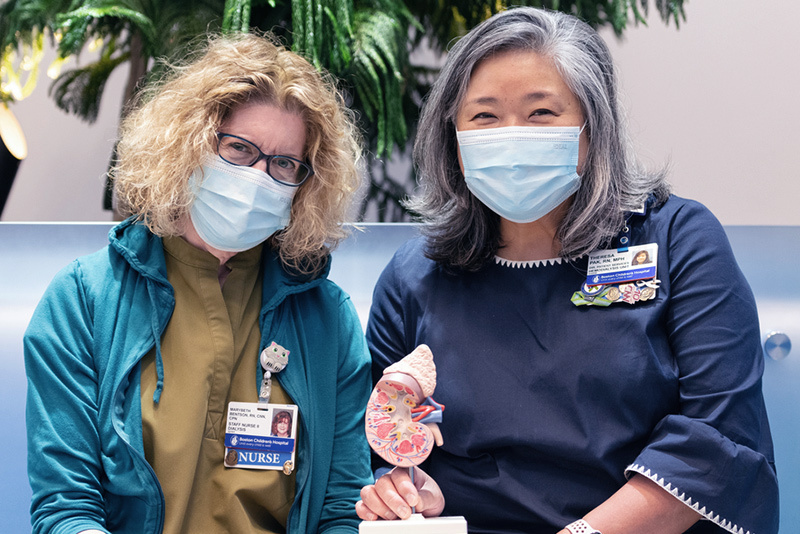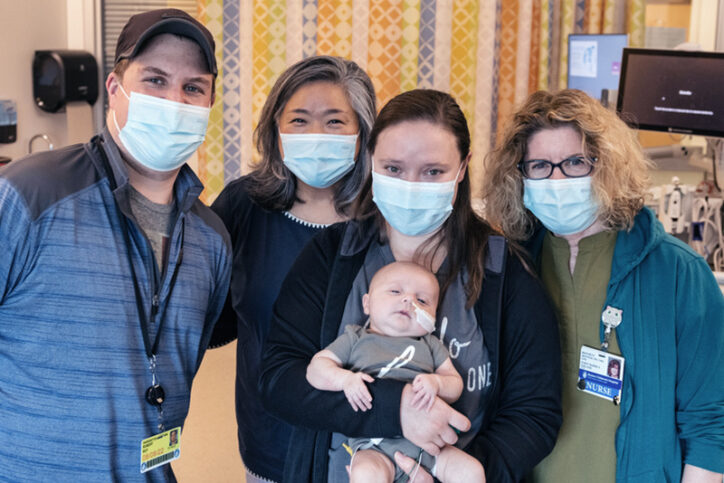If your baby or toddler needs peritoneal dialysis: Tips for parents

Marybeth Bentson and Theresa Pak have helped a lot of families cope with childhood kidney disease. As long-time nurses in the Division of Nephrology at Boston Children’s Hospital, the two have cared for children at every stage of kidney disease, including children on dialysis.
Dialysis filters a child’s blood when their kidneys are unable to do so due to either chronic kidney disease or acute kidney injury. There are two types of dialysis:
- Hemodialysis is performed at a hospital or dialysis center, typically three times a week. A child is connected to a machine that takes blood out of the body, cleans and filters it, and returns it to the child’s bloodstream. This process typically takes between three and four hours.
- Peritoneal dialysis can be performed at home and, unlike hemodialysis, there’s no blood involved. The lining of the belly (peritoneum) does the work of filtering waste out of the blood. The process takes up to 12 hours and has to be done every 24 hours.
“Many parents prefer the convenience of home dialysis,” says Pak, director of patient care in the End-Stage Renal Disease Program. “But it takes some time for parents to feel comfortable giving their child dialysis without a clinician in the room.” Pak has been part of Boston Children’s nephrology team for 17 years.
During her 45 years at Boston Children’s, peritoneal dialysis coordinator Bentson has seen many parents start out uncertain and scared about giving their child dialysis at home only to develop a can-do attitude over time. “Many parents find it empowering to have a hands-on role in their child’s care,” she says.
Here, Bentson and Pak explain peritoneal dialysis and offer advice on giving a child dialysis at home.
How does peritoneal dialysis work?
Bentson: Before the first treatment, a surgeon inserts a soft, hollow tube (catheter) into the child’s belly. The catheter remains in place as long as the child is on dialysis.
For the actual treatments, a parent or clinician attaches the catheter to a dialysis machine called a cycler. The cycler fills the child’s abdomen with a solution (dialysate) that absorbs waste and extra fluid in the belly and then drains it out of the body. Generally, this process happens about 10 times per treatment.
Most parents start the treatments around bedtime so their child can sleep through the process.

How long do children need dialysis?
Pak: If a child is in end-stage renal disease, they’ll need dialysis until they receive a kidney transplant. Children added to the kidney transplant waiting list before they turn 18 rarely wait longer than a year for a donor kidney. (Adults wait an average of five to seven years.)
What do parents need to watch out for during peritoneal dialysis?
Bentson: The two biggest things we keep an eye on are infection and nutrition. We want parents to call us and bring their child in at the first sign of infection so we can intervene right away.
Nutrition is important because many young children on dialysis have feeding issues and are receiving nutrition through a feeding tube. Since most donated kidneys come from adults, babies need to grow and develop before their bodies and blood vessels can support an adult kidney. Nutrition is essential to their growth.
What are the pros and cons of peritoneal dialysis?
Pak: For most babies, peritoneal dialysis is a better option than hemodialysis because it’s more gentle. Peritoneal dialysis tends to have fewer side effects, like cramping and nausea, compared to hemodialysis. And while children on peritoneal dialysis have some dietary restrictions, children on hemodialysis have many more. Many families also prefer the comfort and convenience of giving their child dialysis at home rather than traveling to a hospital or dialysis center three or four times a week for hemodialysis.
But peritoneal dialysis is a lot of work for parents. They need to keep the room where their child receives dialysis clean to prevent infections. They need to store boxes and boxes of supplies at home. Setting up the dialysis machine every night and disconnecting it every morning is a lot of work, and parents always have to monitor their child for signs of infection and other complications, such as fluid overload and dehydration.
What support do you offer parents?
Bentson: We give parents as much information as possible before they bring their child home. We walk them through every stage of the process and have them practice multiple times in the hospital. Before they go home, we give them detailed instructions and make sure they know they can call us any time of the day or night if they run into issues.
Once they’re home, we check in with them every day. Parents send us a daily log of their child’s health status, including weight, blood pressure, and amount of fluid removed so we have a snapshot of how the child is doing.
It’s wonderful to see parents who start out petrified become confident as they see that with this care, their child can grow and potentially do very well.

Learn more about the Division of Nephrology and End-Stage Renal Disease Program.
Related Posts :
-

Unstoppable: Cairo’s journey for kidney care began even before birth
Like lots of babies, Cairo Carter was born screaming — and his parents were thrilled. “We just wanted him to scream ...
-

A new kidney for Kira
Kira Walker knows how to turn a Zoom call into a party. Soon after her mom starts talking, the 8-year-old ...
-

After a long journey and a father's gift, surviving Wilms tumor
Eleanor (Nora) Franks was a happy, healthy toddler who loved playing with her twin brother Evan. But soon after she ...
-

Four things to know about your child’s kidneys
If you’re like most parents, you probably know that the kidneys filter waste from the body and produce urine. ...





